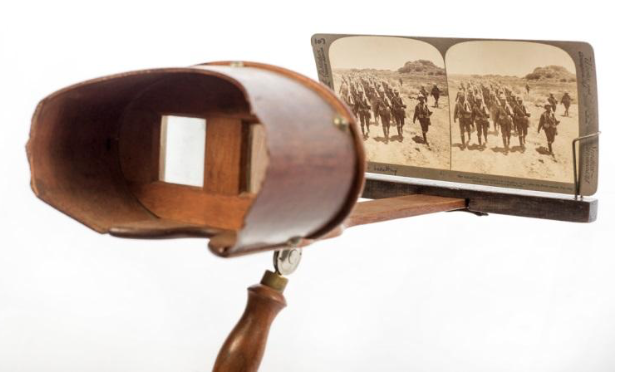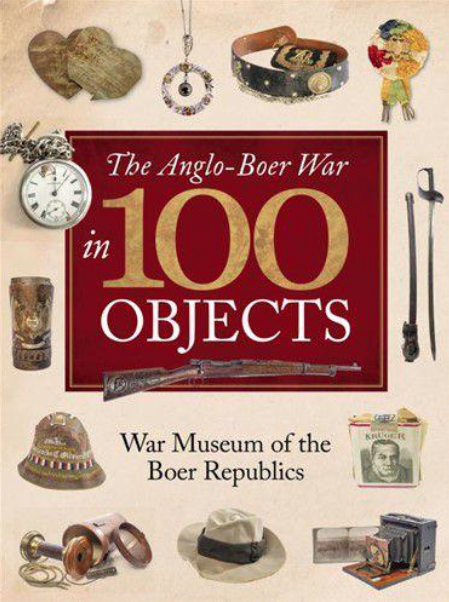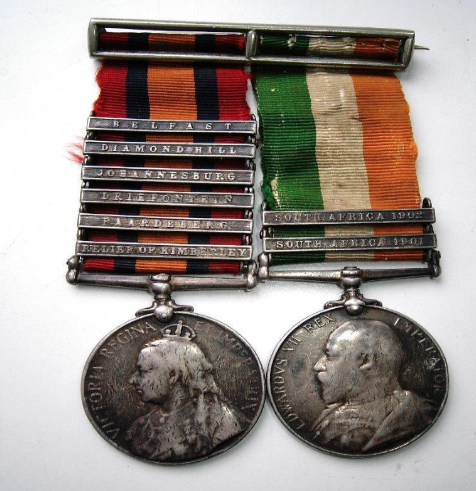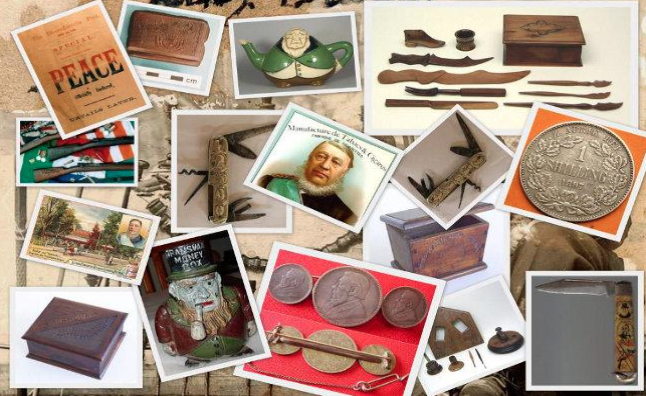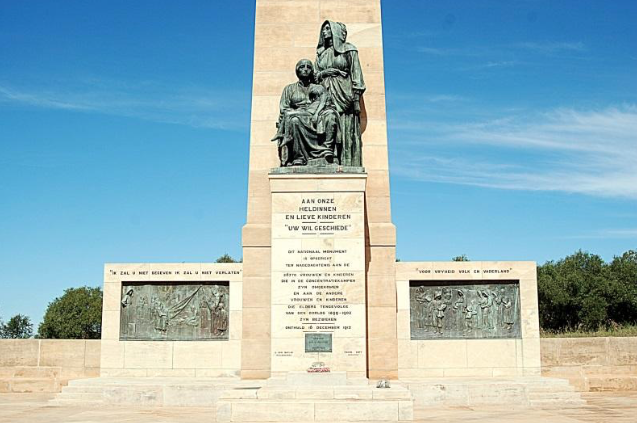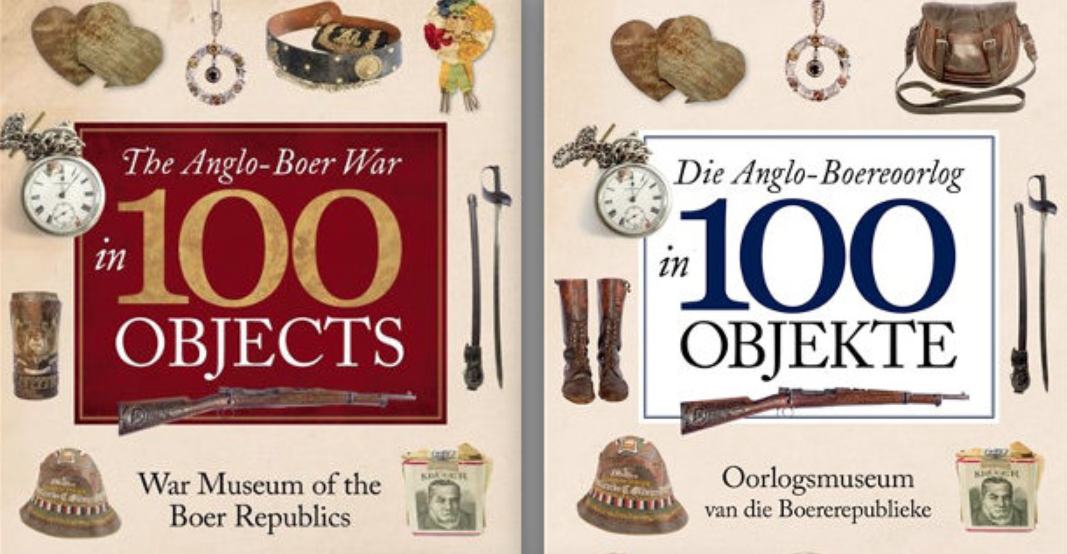
The Second Anglo Boer War (1899 to 1902) was a disaster for both victor and vanquished. For the British it was an excessively costly colonial adventure and a complete miscalculation of likely duration. Both Afrikaners and African people lost more than they gained in defeat, occupation, starvation, destruction of farms, exile and imprisonment. The two Boer republics were lost and with it Afrikaner independence. The British taxpayer footed a very expensive escapade where generals still thought about fighting set piece battles on the veld. Both sides made appalling mistakes and tried to disguise their errors and heavy loss of men in those grand boys own adventure tales of heroism and bravado.
Stereoscopic viewer from the collection of the Anglo Boer War Museum, Bloemfontein.
Perhaps though, the hideous decision from 1900 (following the shift to the guerrilla phase) to burn the farms and move the women and children, black and white, into what were called concentration camps was the feature of warfare that was most unbearable. The death through disease, a lack of food, and disorganized chaos and mismanagement by the military who had no idea of how to deal with these thousands of civilian women and children directed to hastily created camps and placed in inadequate tents was a crime against humanity. It is estimated that over 26 000 white people and about 24 000 black people died through disease, epidemics, malnourishment, putrid water and poor management. The vast majority were children. Emily Hobhouse was the British woman who came to South Africa and exposed the conditions through publicity and the right connections back in British parliamentary circles.
The Boer War should never have happened and its deeper causes as well as the errors of strategy, direction, management and mismanagement are still controversial and debated in books and articles. The War has spawned a huge literature from the scholarly monograph and magisterially commanding to the reminiscences and personal memoirs to the propagandistic. Contemporary accounts and the blow by blow narratives at the time of the war gave way to later more coolly interpretive and analytical texts. Eventually it seemed that the subject was exhausted but each generation comes back to ask its own questions about causes, events and consequences. There are new historiographical questions asked of the evidence and various sub-branches of historical study tackle the subject afresh.
Anglo Boer War Museum Building, Bloemfontein.
One revived history has been the social dimension. Historiography has shifted towards the stories of people and individuals who lived at the time and were caught up in events.
The War Museum of the Boer Republics happens to be in Bloemfontein in the Free State and the Museum is to be congratulated on compiling a splendid book on the War from the personal angle. It is rich in illustrations and will have wide appeal because it has a fine visual look and tactile feel. This is a book of the memorabilia that somehow survived battle, the ravages of time, migration, war and disaster. It is a book of impressive photographic reproductions (some photos are still quite disturbing e.g. a child on his deathbed or a child laid out in a coffin).
Book Cover
One pauses to ask is this history or is it a sort of latent and simmering propaganda. Surely it can’t be propaganda? This is a war that happened nearly 120 years ago and yet it is a book that is strongly emotional because it relates the history of the Anglo Boer War through photographs and those everyday items, big and small from a child’s outfit or a battered hat or a sweetheart brooch made of bone or a pen used to sign the final peace treaty to a Boer rifle or a Broadwood piano or a tattered flag of a general’s chair or another general’s saddle. Here are all treasures preserved and passed on through the generations of Afrikaners. I know in my own family we have saved photographs, medals and a couple of albert chains made in a prisoner of war camp in Ceylon.
Anglo-Boer War medals for sale on Ebay
The book is available in both English and Afrikaans and the quality of the printing, the substantial weight and gloss of the paper, the layout colour print illustrations and the firm hard cover binding gives us an excellent product at a very good price.
The book is aimed at the popular market and follows the international trends to bring history back to ordinary people, descendants of the people who survived the catastrophe of war. This is their story but it becomes our story too. Many of these small items speak to the heart and have a nostalgia and a sadness that goes beyond words. For me, and I imagine for many South Africans whose grandparents or great grandparents were victims of the concentration camps, this book will tell you the personal stories that are proxies for your own family history.
Boer War memorabilia from the Anglo Boer War Museum , Bloemfontein. War museum website.
It is a book that introduces the museum in Bloemfontein through 100 artefacts drawn from the museum’s collection. Each of the 100 selected objects is marked with a small logo of a Long Tom cannon, but there are other supplementary items and photographs almost to the point of confusion. More could have been said about the reasons behind the selection of items - it is not quite as self-explanatory as the curators may think. Bloemfontein was the capital of the Republic of the Orange Free State and the raising of the sieges of Kimberley and Mafikeng and then the fall of Bloemfontein and the occupation of Pretoria and Johannesburg marked a turning point in the war with the shift from battles and sieges to skirmishes and guerrilla tactics and so into the saddest phase of the concentration camps and the overseas prison camps in Ceylon, Bermuda and St Helena.
National Women’s Memorial, Bloemfontein – Anton van Vouw , source Wikimedia commons.
The items chosen for the book are supplemented with a rich collection of photographs of people, places, battles, events and maps. The appeal lies entirely in the visual presentation and its these photographs and small items that bring a critical period of South African history alive in a way that is reminiscent of those large magazines of the past such as the Illustrated London News or the Black and White Budget, but this time the perspective is unashamedly South African and completely on the side of the Boers. The organization of the material follows a chronological and narrative sequence with essays on topics such as the initial battles, Black Week and the fall of the Republics, the weapons of the soldiers of the war, medical services, the cast of characters, the guerrilla phase, the scorched earth and the concentration camps and the prisoners of war. The final chapter deals with the peace process and legacy of the war.
The aim of such a volume is to connect the reader to a place or an event through looking for the small artefacts and treasures. The stories of individuals such as Count de Villebois-Mareuil a French aristocrat and veteran of the Franco Prussian War who joined the Boers as a foreign volunteer, or little child Jurgens Nieman who was shot accidentally and died, or the exploits and escape of John de Villiers. All these stories give you an insight into what happened to people who were heroes, leaders, soldiers or civilian victims. These are the poignant details. This book exudes nostalgia, tragedy and emotion.
I first knew about the Boer War through the oral history of our family. My grandmother was in the Bethulie concentration camp; she was of Afrikaner and Dutch descent. She survived, married one Irishman (he died and left her with a child) and then another Irishman (my grandfather) who had fought on the side of the British. I knew this as a war that divided families and I grew up knowing all about the work of Emily Hobhouse and that she was something of a saint in Afrikaner eyes. My mother told me that she never knew very much about the Boer war until she in turn married an Englishman and went to England as a war bride and her new English relatives did not like it that their son was seen as an outsider. She wailed, ”but it was 45 years ago“. That plea made little difference and she learnt a bit about the English viewpoint when she saw the Boer War memorials very common in English towns and villages.
Now we are in the 21st century but it is still a war that generates an emotional response and this book effervesces on that emotion. The Boer War happened more than 100 years ago but its legacy lingered in memory and family histories for generations. The museum’s selected 100 iconic objects gives a certain raw edginess to those memories. The idea of “doing history” in 100 objects is now well established. We have already had Neil MacGregor’s History of the World in 100 Objects, which started as a BBC series in 2010 and drew on artefacts from the British Museum. Then there was The History of the First World War in 100 Objects by Gary Sheffield (2015). I see that there is also a history of Ireland in 100 Objects. There’s a history of the Universe in 100 objects, or the history of Football in 100 objects and even a history of the Future in 100 objects. Clearly it is a publishing gimmick that works and sells books. People are rediscovering history through “things” the cultural survivals and collected and collectable items that arrived in museums.
The 100 objects method works well too as a teaching tool. History stops being dry and instead becomes a treasure hunt. Using objects and items that have survived is an excellent way of bringing history to life in the classroom. There is a real challenge in making events that happened more than a century ago relevant to the child of today; too often even the university student sees history as starting just the year before he was born. Well this is a book to spark an interest and it has all the hallmarks of passionate partisan history that sparks interest and hopefully leads to questions. I believe though that its books such as this that has fed a revival of interest in history and although there is a tension between museum visibility and authoritative history, it is an approach that connects modern people with their ancestors of perhaps four or so generations ao.
The limitations of this type of history is that it is history for the internet and television age. Interpretation, nuance and depth are lost. Simplification and a tangible feel result in a sound bite look to the page. Attention spans need stretch no further than a box on a page and an accompanying illustration. But I am being harsh, as this book’s clear objective is to showcase the collection of a museum and if it serves the purpose of scooping up the curious and leading them to ask questions about items behind glass then the museum itself gains new enthusiasts. There is a select bibliography and I see that two of my favourite Boer War books (Packenham and Judd and R Kruger are here ) but I would also have included JS Marais and G H L Le May. So by all means read and buy the Anglo Boer War in 100 objects but then step out of the museum and into a library to tackle more literature of this war that shaped the South African 20th century and had a powerful influence on the world we inherited.
Kathy Munro is an Honorary Associate Professor in the School of Architecture and Planning at the University of the Witwatersrand. She enjoyed a long career as an academic and in management at Wits University. She trained as an economic historian. She is an enthusiastic book person and has built her own somewhat eclectic book collection over 40 years. Her interests cover Africana, Johannesburg history, history, art history, travel, business and banking histories. She researches and writes on historical architecture and heritage matters. She is a member of the Board of the Johannesburg Heritage Foundation and is a docent at the Wits Arts Museum. She is currently working on a couple of projects on Johannesburg architects and is researching South African architects, war cemeteries and memorials. Kathy is a member of the online book community the Library thing and recommends this cataloging website and worldwide network as a book lover's haven.

